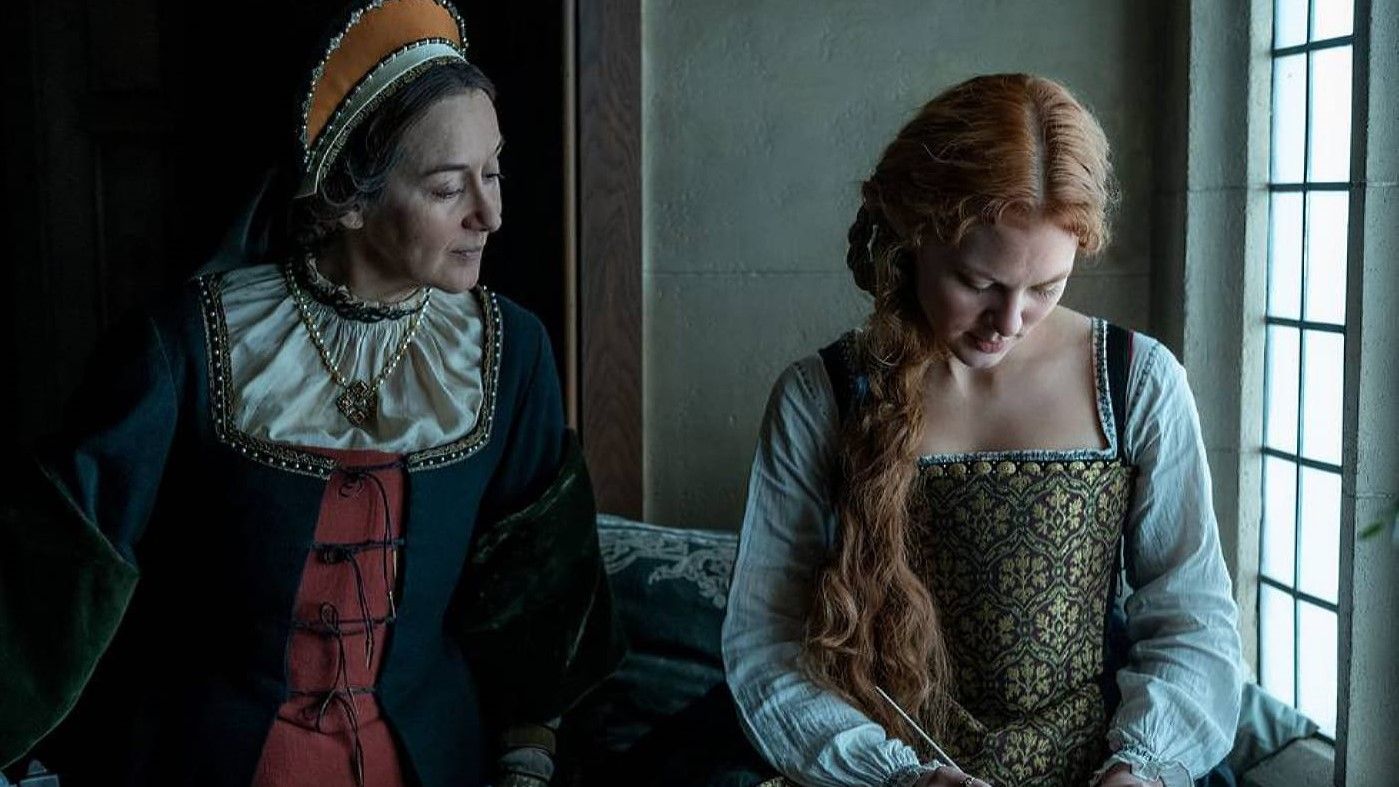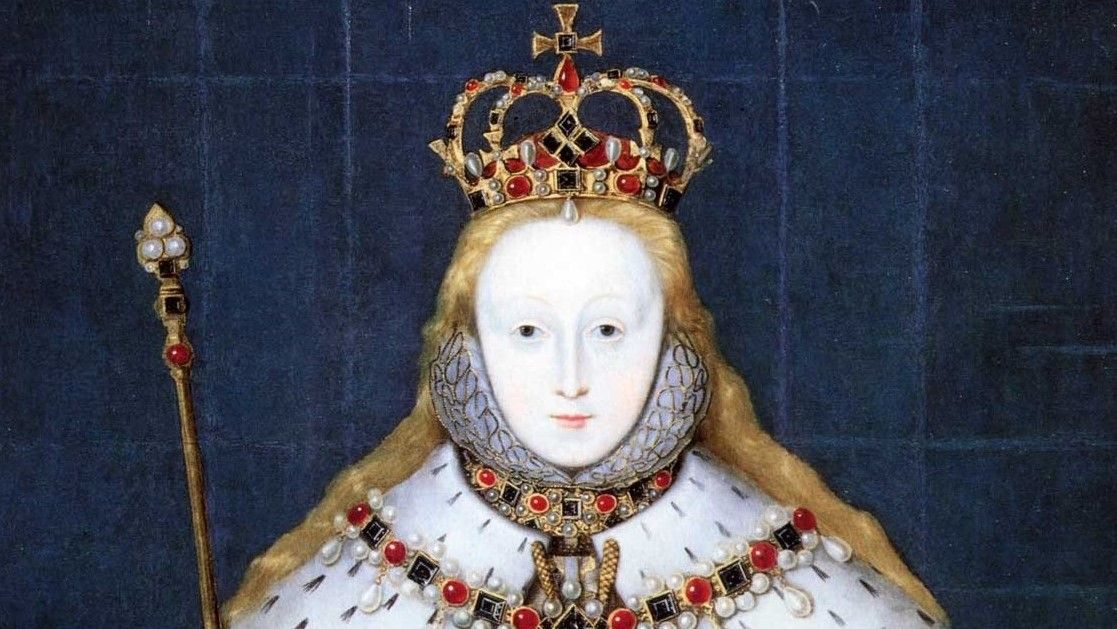Becoming Elizabeth is Starz’s newest epic period drama based on the life of one of England’s most well-known queen, Elizabeth I. While there have been many movies and TV series made about Elizabeth I, Becoming Elizabeth tells the story of the younger years of the future Queen, when her access to the throne was but a mere fantasy.
Starring Alicia von Rittberg as Elizabeth, the series begins in 1547 with the death of Henry VIII, her father, and father of Mary Tudor (Romola Garai) and Edward VI (Oliver Zetterström), all born from a different mother. Indeed, King Henry VIII is famously known for having been married to six different women throughout his life, and for the extreme violence with which he treated almost all of them.
In the first episode, we can clearly see that the three children care about each other. Edward is 9, Elizabeth 14, and Mary is about to turn 31. When Edward is crowned King, the young boy feels distressed and worried to be taken away from his sister, Elizabeth. The two sisters, Mary Tudor and Elizabeth, get along as well; however, the relationship between the three siblings is soon darkened not only by the schemes and lies of the Royal Court, but also by a war of religion and ideology between Catholics and Protestants. In the Starz series, this complex relationship is extremely well depicted, and while we see things go awry for the two sisters in the second episode, their sisterhood will only go from bad to worse from there.
Mary I and Elizabeth I in History
In order to fully understand Mary and Elizabeth’s relationship in the TV series, we need to go back in history, to study the past of these three characters, and we need to keep it simple!
Mary’s mother was Katherine of Aragon, a Spanish princess who was first married to Henry VIII’s older brother, Arthur, who died shortly after their marriage. Henry VIII eventually married Katherine and together had many children. However, only Mary survived, born in 1516. But the King was in desperate need of a male heir. Henry then met Anne Boleyn and completely fell in love with her (and with the idea that he might have a boy with her).
He decided to divorce Katherine, but the queen was a Roman Catholic, and divorce wasn’t an option, especially since the Pope wouldn’t agree to this separation. After a long battle between the King and the Queen, Henry VIII finally disregarded the decision of the Pope, who according to the king, didn’t have a say in what happened in the English Court. After some 24 years of marriage, Katherine was eventually exiled and cruelly separated from her daughter. Mary was no longer a princess, but only a Lady.
From his marriage to Anne Boleyn, Henry had a daughter, Elizabeth. But the king doubted his wife’s faithfulness, and Anne Boleyn was executed by order of the king on charges of adultery and treason, when Elizabeth was barely 3 years old. Anne Boleyn’s reputation played a major role in Elizabeth’s upbringing and in the legitimacy of her ascension to the throne. Many people believed that she wasn’t actually Henry’s daughter, but one of Anne’s lovers. She was also believed to be illegitimate because the majority of Catholics wouldn’t recognize divorce and believed that Henry VIII wasn’t actually married to Anne Boleyn after his divorce from Katherine of Aragon.
Finally, Henry VIII had a boy, Edward VI, with Jane Seymour in 1537. The boy is crowned king at 9 years old. While Edward VI died just a few years later when he was 15, he built the foundation of the English Reformation, one of England’s biggest social and religious changes, which placed Protestantism as “The True Faith,” and repudiated Catholicism, to the dismay of his sister, the very Catholic Mary Tudor.
In Episode 2 of Becoming Elizabeth, we get a very clear glance at Elizabeth and Mary’s unstable relationship. Living with Catherine Parr (Henry’s latest wife portrayed by Jessica Raine) and her new husband, Thomas Seymour (Tom Cullen), Elizabeth is caught up in the rise of Protestantism and in the downfall of Catholicism. After Mary is asked by Edward to reject her faith and convert to Protestantism, she decides to return to the countryside. Mary is desperate for Elizabeth to come live with her and to “save her soul.” However, the young woman decides to stay at court and join her brother in his Protestantism reform.
In the third episode of Becoming Elizabeth, Mary Tudor feels threatened by her siblings and their religion, which becomes a concern for the Court, since Mary has a big Catholic support that could very well try to oust the current king, as well as his faith. Mary Tudor isn’t even invited to Elizabeth’s 15th birthday party. This is the beginning of the end of their sisterhood, if there really ever was one.
Over the years, the two sisters’ relationship will be worn out by doubts and treasons. When Edward VI was dying at age 15, he tried to leave the crown to his Protestant cousin, Lady Jane Grey, portrayed by Bella Ramsey in Becoming Elizabeth. Mary and Elizabeth joined forces in what could be interpreted as a once in a lifetime sisterly and feminine solidarity action, to claim their right to the throne. Together, they marched on London with their own army. Mary I was the new queen, and Elizabeth was queen-in-waiting. Mary I reigned for a duration of five years, and was later given the infamous nickname of Bloody Mary. Indeed, the queen put her Catholic faith first and tried to restore the Catholic Church in England. She ordered hundreds of Protestants to be burned at the stake as heretics.
The relationship between Elizabeth and Mary was once again in danger, as Elizabeth still remained a Protestant, and in line for the throne. In short, Elizabeth was a threat for both Mary and the future of Catholicism. The young woman retreated to the countryside to stay away from the plots and intrigues of the Court.
A Protestant rebellion erupted, after it was announced that Mary I was going to marry a fanatical Catholic, King Philip II of Spain, which would signify the arrival of the Spanish Inquisition in England, as well as the potential birth of a new Catholic heir.
After many conspiracies against Mary were avoided, Elizabeth was caught up in one gigantic scheme to overrule Mary, who eventually ordered her half-sister to be arrested and taken to the Tower of London in 1554, which she had to enter through the Traitor’s Gate. She was eventually released after eight weeks (on terms that she had to convert to Catholicism, which Elizabeth had no other choice than to agree). She was then guarded in a house of arrest, released again and then even “reconciled” with her sister Mary, who was advised by her husband. In 1558, Mary I died after her health had become increasingly fragile. Elizabeth was finally able to access the throne during what is called the Elizabethan Era, which lasted 45 years. She rapidly reestablished a Protestant majority at court, even though she was known to be a bit more tolerant when it came to religion (only if it wasn’t a direct threat to her and her power, of course).
Throughout her life, her position as Queen of England was questioned by many people who still didn’t believe she was Henry’s legitimate daughter. One woman in particular was a serious threat to Elizabeth’s sovereignty: Mary Stuart, aka Mary Queen Of Scots, a Catholic, Elizabeth’s cousin and granddaughter of King Henry VIII’s elder sister, Margaret. Interesting fact, in the first episode of Becoming Elizabeth, you can actually hear young King Edward VI argue that he won’t marry a 5-years-old Mary Queen of Scots. This scene is a direct reference to an arrangement made by Henry VIII that his son would marry Mary Stuart. That plan was however objected by Scottish Catholics since England had separated from the Catholic Church.
No doubt the next episodes of Becoming Elizabeth will show Mary and Elizabeth’s relationship in dangerous decline and the increasing tensions between Catholics and Protestants.

























































![LinkedIn Provides Tips on How to Promote Live Events [Infographic] LinkedIn Provides Tips on How to Promote Live Events [Infographic]](https://imgproxy.divecdn.com/kA4YczoBIs8NmPBiERWa-OxzvYMz5kwjjZ6wewP8z7c/g:ce/rs:fit:770:435/Z3M6Ly9kaXZlc2l0ZS1zdG9yYWdlL2RpdmVpbWFnZS9saW5rZWRpbl9ldmVudF9hZHNfaW5mb18yLnBuZw==.webp)

















